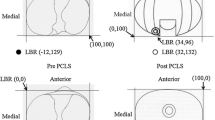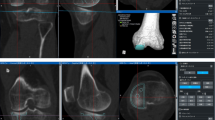Abstract
Purpose
Successful outcome after total knee arthroplasty (TKA) requires precise realignment of the mechanical axis. The intraoperative assessment of the mechanical axis is difficult. Intraoperatively, the effect of weight bearing on the lower limb mechanical axis is ignored. We developed a custom-made mechanical loading device to simulate weight-bearing conditions intraoperatively and analysed its effect on the mechanical axis during TKA.
Methods
Measurements of the mechanical axis were obtained during 30 consecutive primary TKAs in osteoarthritic patients using image-free knee navigation system. Half body weight was applied intraoperatively using our device to quantify the effect of intraoperative load application on the mechanical axis, thus receiving indirect information about soft tissue balancing. Furthermore, the intraobserver and interobserver reliability of navigated mechanical axis measurement with and without load was determined.
Results
Before TKA, mean mechanical axis was 4.0° ± 4.9° without load. Under loading conditions, the mean change of the mechanical axis was 2.1° ± 2.8°. Repetitive measurements of the senior surgeon and junior surgeon revealed a high intraobserver (ICC 0.997) and interobserver reliability (ICC 0.998). The registration of the mechanical axis without and with application of intraoperative loading demonstrated no significant differences during insertion of the trial components (SD 0.29 ± 0.29) and after the definitive component cementation (SD 0.63 ± 0.44).
Conclusions
Intraoperative quantification and analysis of the mechanical lower limb axis applying defined axial loading by our custom-made loading apparatus is reliable. Ligament stability was unbalanced before TKA and balanced after TKA. For TKA, intraoperative simulation of weight bearing may be helpful to quantify, control and correct knee stability and its influence of mechanical axis.

Similar content being viewed by others
References
Lotke PA, Ecker ML (1977) Influence of positioning of prothesis in total knee replacement. J Bone Joint Surg 59A:77
Moreland JR (1988) Mechanisms of failure in total knee arthroplasty. Clin Orthop Relat Res 226:49
Ritter MA, Faris PM, Keating EM, Meding JB (1994) Postoperative alignment of total knee replacement—its effect on survival. Clin Orthop Relat Res 299:153–156
Krackow KA (2003) Instability in total knee arthroplasty 18 (Suppl 3):45–47
Whiteside LA (2002) Soft tissue balancing: the knee. J Arthroplast17 (Suppl 1)
Mihalko WM, Whiteside LA, Krackow K (2003) Comparison of ligament-balancing techniques during total knee arthroplasty. J Bone Joint Surg 85A(Suppl 4):132–135
Winemaker MJ (2002) Perfect balance in total knee arthroplasty. J Arthroplast 17(Suppl 1):2–10
Griffin FM, Insall JN, Scuderi GR (2000) Accuracy of soft tissue balancing in total knee arthroplasty. J Arthroplast 15(8):970–973
Siston RA et al (2007) Coronal plane stability before and after total knee arthroplasty. Clin Orthop Relat Res 463:43–49
Bäthis H, Perlick L, Tingart M, Lüring C, Zurakowski D, Grifka J (2004) Alignment in total knee arthroplasty. A comparison of computer-assisted surgery with the conventional technique. J Bone Joint Surg Br 86:682–687
Kim SJ, MacDonald M, Hernandez J, Wixson RL (2005) Computer assisted navigation in total knee arthroplasty: improved coronal alignment. J Arthroplast 20(Suppl 3):123–131
Kendoff D, Board TN, Citak M, Gardner MJ, Hankemeier S, Ostermeier S, Krettek C, Hüfner T (2008) Navigated lower limb axis measurements: influence of mechanical weight-bearing simulation. J Orthop Res 26:553–561
Freeman MA, Todd RC, Bamert P, Day WH (1978) ICLH arthroplasty of the knee: 1968–1977. J Bone Joint Surg Br 60:339–344
Insall JN, Binazzi R, Soudry M, Mestriner LA (1985) Total knee arthroplasty. Clin Orthop Relat Res 192:13–22
Font-Rodriguez DE, Scuderi GR, Insall JN (1997) Survivorship of cemented total knee arthroplasty. Clin Orthop Relat Res 345:79–86
Rodriguez JA, Bhende H, Ranawat CS (2001) Total condylar knee replacement: a 20-year follow up study. Clin Orthop Relat Res 388:10–17
Siston RA, Daub AC, Giori NJ, Goodman SB, Delp SL (2005) Evaluation of methods that locate the center of the ankle for computer-assisted total knee arthroplasty. Clin Orthop Relat Res 439:129–135
Jeffery RS, Morris RW, Denham RA (1991) Coronal alignment after total knee replacement. J Bone Joint Surg Br 73:709–714
Rand JA, Coventry MB (1988) Ten-year evaluation of geometric total knee arthroplasty. Clin Orthop Relat Res 232:168–173
Bäthis H, Perlick L, Lüring C, Kalteis T, Grifka J (2003) CT-basierte und CT freie Navigation in der Knieendoprothetik—Ergebnisse einer prospektiven Studie. Unfallchirurg 106:935–940
Oberst M, Bertsch C, Würstlin, Holz U (2003) CT-Analyse der Beinachse nach konventioneller vs. navigierter Knieendoprothese—Erste Ergebnisse einer kontrollierten, prospektiven und randomisierten Studie. Unfallchirurg 106:941–948
Sparmann M, Wolke B, Czupalla H (2003) Positioning of total knee arthroplasty with and without navigation support. A prospective, randomized study. J Bone Joint Surg Br 85:830–835
Catani F, Biasca N, Ensini A, Leardini A, Bianchi L, Digennaro V, Giannini S (2008) Alignment deviation between bone resection and final implant positioning in computer-navigated total knee arthroplasty. J Bone Joint Surg Am 90:765–771
Hsu HP, Garg A, Walker PS, Spector M, Ewald FC (1989) Effect of knee component alignment on tibial load distribution with clinical correlation. Clin Orthop Relat Res 248:135–144
Takahashi T, Wada Y, Yamamoto H (1997) Soft-tissue balancing with pressure distribution during total knee arthroplasty. J Bone Joint Surg Br 79B:235–239
Haaker RG, Stockheim M, Kamp M, Proff G, Breitenfelder J, Ottersbach A (2005) Computer-assisted navigation increases precision of component placement in total knee arthroplasty. Clin Orthop Relat Res 433:152–159
Ensini A, Catani F, Leardini A, Romagnoli M, Giannini S (2007) Alignments and clinical results in conventional and navigated total knee arthroplasty. Clin Orthop Relat Res 457:156–162
Tew M, Waugh W (1985) Tibial-femoral alignment and the results of knee replacement. J Bone Joint Surg Br 67B:551–556
Schwanson KE, Stocks GW, Warren PD, Hazel MR, Janssen HF (2000) Does axial limb rotation affect the alignment measurements in deformed limbs? Clin Orthop Relat Res 371:246–252
Acknowledgments
No professional or private funding was received for this study. All authors are only affiliated with their mentioned trauma/orthopaedic departments in Hannover and belong to the specific medical universities.
Author information
Authors and Affiliations
Corresponding author
Rights and permissions
About this article
Cite this article
Panzica, M., Kenawey, M., Liodakis, E. et al. Effect of intraoperative weight-bearing simulation on the mechanical axis in total knee arthroplasty. Arch Orthop Trauma Surg 134, 673–677 (2014). https://doi.org/10.1007/s00402-014-1938-3
Received:
Published:
Issue Date:
DOI: https://doi.org/10.1007/s00402-014-1938-3




